Financial Accounting Assignment: Trial Balance, Statements, and Ratios
VerifiedAdded on 2023/01/11
|19
|4404
|22
Homework Assignment
AI Summary
This financial accounting assignment provides a comprehensive analysis of key accounting principles and practices. It begins with the formulation of a trial balance, followed by the application of the double-entry system and the creation of ledgers. The assignment then delves into the preparation of financial statements, including the profit and loss account and balance sheet, in accordance with International Accounting Standards. It also includes the calculation and interpretation of various financial ratios to assess the financial performance and position of a business. Furthermore, the assignment covers the differences between financial reports and financial statements. The document presents a detailed overview of financial accounting, including its importance for stakeholders and the regulations that govern it.
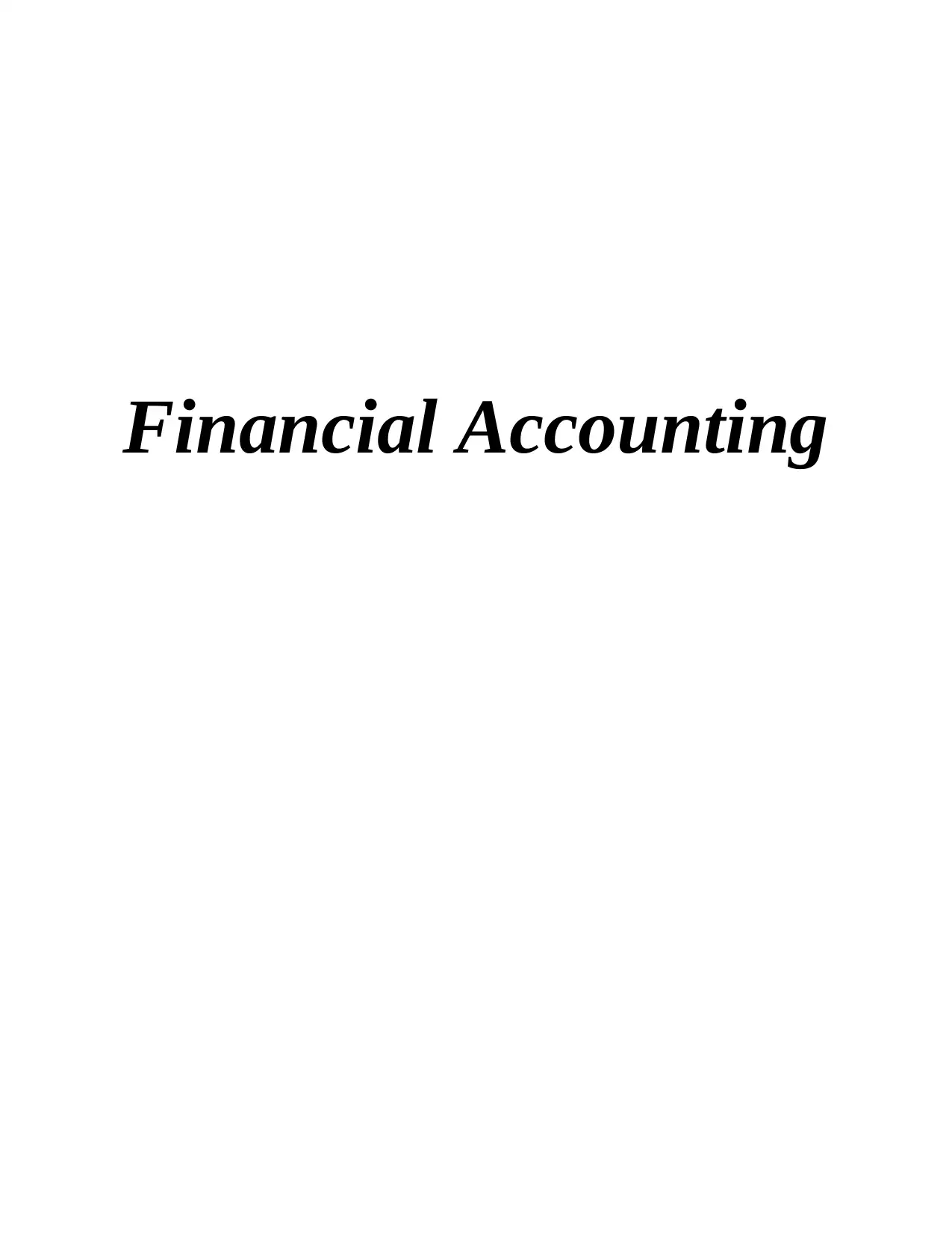
Financial Accounting
Paraphrase This Document
Need a fresh take? Get an instant paraphrase of this document with our AI Paraphraser
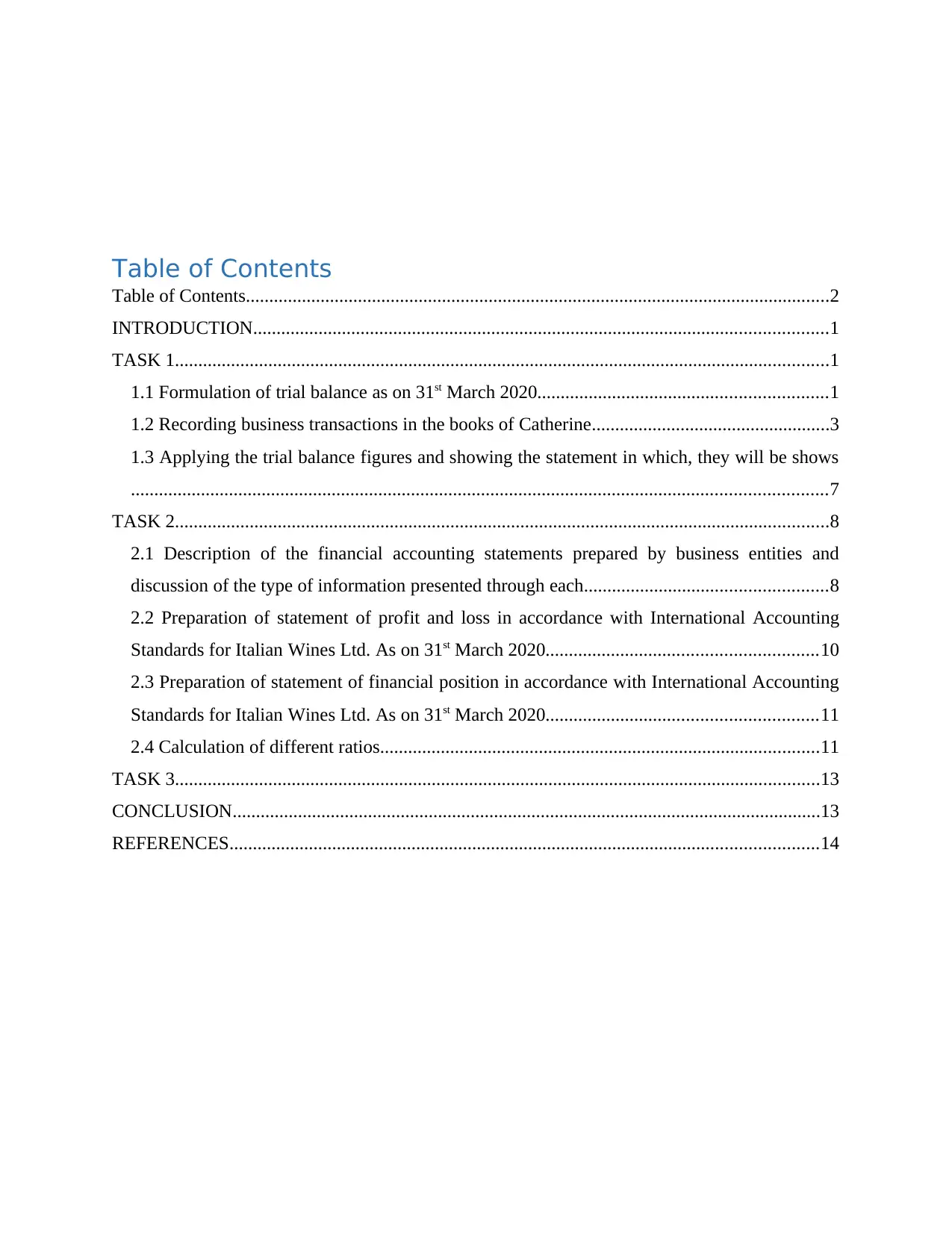
Table of Contents
Table of Contents.............................................................................................................................2
INTRODUCTION...........................................................................................................................1
TASK 1............................................................................................................................................1
1.1 Formulation of trial balance as on 31st March 2020..............................................................1
1.2 Recording business transactions in the books of Catherine...................................................3
1.3 Applying the trial balance figures and showing the statement in which, they will be shows
.....................................................................................................................................................7
TASK 2............................................................................................................................................8
2.1 Description of the financial accounting statements prepared by business entities and
discussion of the type of information presented through each....................................................8
2.2 Preparation of statement of profit and loss in accordance with International Accounting
Standards for Italian Wines Ltd. As on 31st March 2020..........................................................10
2.3 Preparation of statement of financial position in accordance with International Accounting
Standards for Italian Wines Ltd. As on 31st March 2020..........................................................11
2.4 Calculation of different ratios..............................................................................................11
TASK 3..........................................................................................................................................13
CONCLUSION..............................................................................................................................13
REFERENCES..............................................................................................................................14
Table of Contents.............................................................................................................................2
INTRODUCTION...........................................................................................................................1
TASK 1............................................................................................................................................1
1.1 Formulation of trial balance as on 31st March 2020..............................................................1
1.2 Recording business transactions in the books of Catherine...................................................3
1.3 Applying the trial balance figures and showing the statement in which, they will be shows
.....................................................................................................................................................7
TASK 2............................................................................................................................................8
2.1 Description of the financial accounting statements prepared by business entities and
discussion of the type of information presented through each....................................................8
2.2 Preparation of statement of profit and loss in accordance with International Accounting
Standards for Italian Wines Ltd. As on 31st March 2020..........................................................10
2.3 Preparation of statement of financial position in accordance with International Accounting
Standards for Italian Wines Ltd. As on 31st March 2020..........................................................11
2.4 Calculation of different ratios..............................................................................................11
TASK 3..........................................................................................................................................13
CONCLUSION..............................................................................................................................13
REFERENCES..............................................................................................................................14
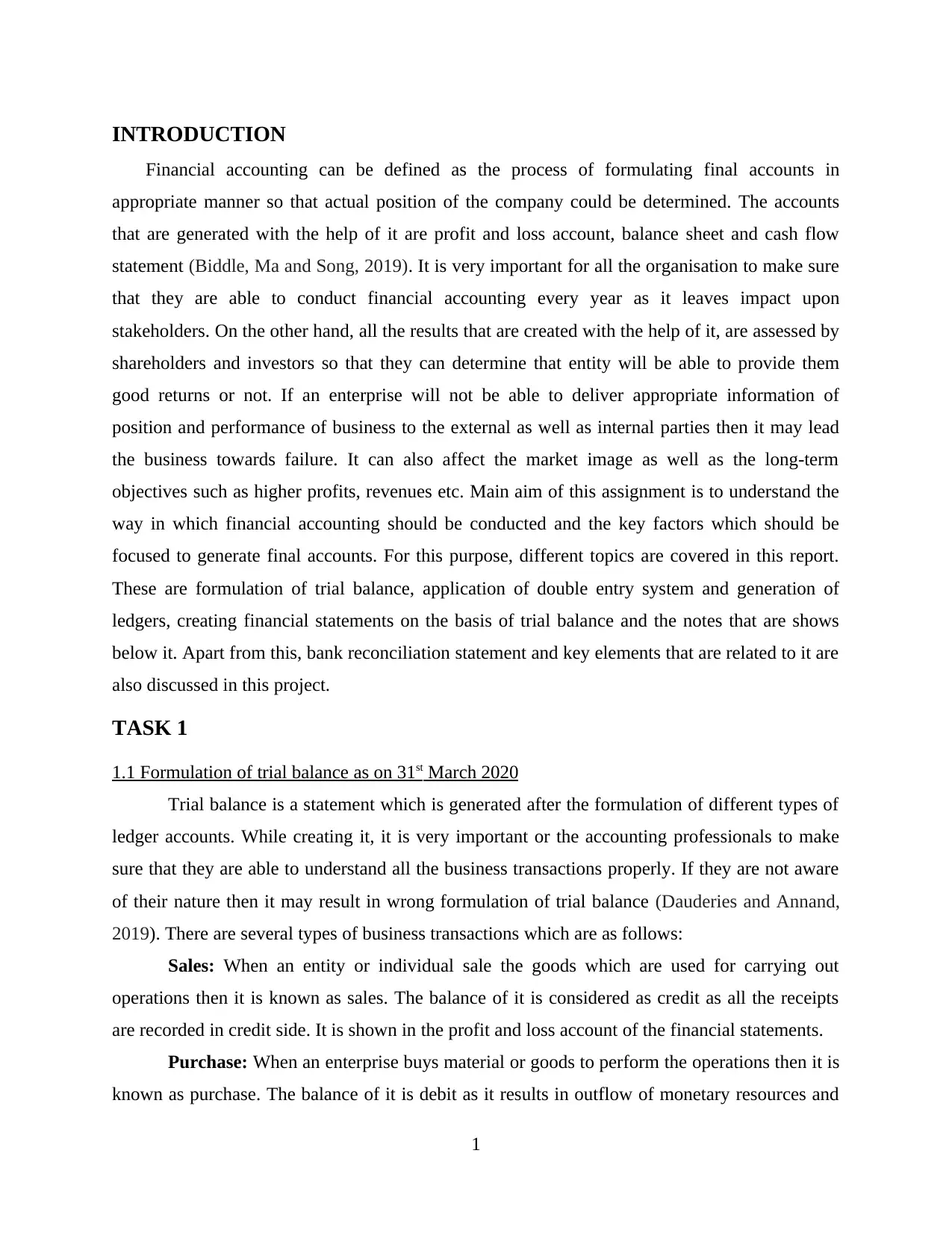
INTRODUCTION
Financial accounting can be defined as the process of formulating final accounts in
appropriate manner so that actual position of the company could be determined. The accounts
that are generated with the help of it are profit and loss account, balance sheet and cash flow
statement (Biddle, Ma and Song, 2019). It is very important for all the organisation to make sure
that they are able to conduct financial accounting every year as it leaves impact upon
stakeholders. On the other hand, all the results that are created with the help of it, are assessed by
shareholders and investors so that they can determine that entity will be able to provide them
good returns or not. If an enterprise will not be able to deliver appropriate information of
position and performance of business to the external as well as internal parties then it may lead
the business towards failure. It can also affect the market image as well as the long-term
objectives such as higher profits, revenues etc. Main aim of this assignment is to understand the
way in which financial accounting should be conducted and the key factors which should be
focused to generate final accounts. For this purpose, different topics are covered in this report.
These are formulation of trial balance, application of double entry system and generation of
ledgers, creating financial statements on the basis of trial balance and the notes that are shows
below it. Apart from this, bank reconciliation statement and key elements that are related to it are
also discussed in this project.
TASK 1
1.1 Formulation of trial balance as on 31st March 2020
Trial balance is a statement which is generated after the formulation of different types of
ledger accounts. While creating it, it is very important or the accounting professionals to make
sure that they are able to understand all the business transactions properly. If they are not aware
of their nature then it may result in wrong formulation of trial balance (Dauderies and Annand,
2019). There are several types of business transactions which are as follows:
Sales: When an entity or individual sale the goods which are used for carrying out
operations then it is known as sales. The balance of it is considered as credit as all the receipts
are recorded in credit side. It is shown in the profit and loss account of the financial statements.
Purchase: When an enterprise buys material or goods to perform the operations then it is
known as purchase. The balance of it is debit as it results in outflow of monetary resources and
1
Financial accounting can be defined as the process of formulating final accounts in
appropriate manner so that actual position of the company could be determined. The accounts
that are generated with the help of it are profit and loss account, balance sheet and cash flow
statement (Biddle, Ma and Song, 2019). It is very important for all the organisation to make sure
that they are able to conduct financial accounting every year as it leaves impact upon
stakeholders. On the other hand, all the results that are created with the help of it, are assessed by
shareholders and investors so that they can determine that entity will be able to provide them
good returns or not. If an enterprise will not be able to deliver appropriate information of
position and performance of business to the external as well as internal parties then it may lead
the business towards failure. It can also affect the market image as well as the long-term
objectives such as higher profits, revenues etc. Main aim of this assignment is to understand the
way in which financial accounting should be conducted and the key factors which should be
focused to generate final accounts. For this purpose, different topics are covered in this report.
These are formulation of trial balance, application of double entry system and generation of
ledgers, creating financial statements on the basis of trial balance and the notes that are shows
below it. Apart from this, bank reconciliation statement and key elements that are related to it are
also discussed in this project.
TASK 1
1.1 Formulation of trial balance as on 31st March 2020
Trial balance is a statement which is generated after the formulation of different types of
ledger accounts. While creating it, it is very important or the accounting professionals to make
sure that they are able to understand all the business transactions properly. If they are not aware
of their nature then it may result in wrong formulation of trial balance (Dauderies and Annand,
2019). There are several types of business transactions which are as follows:
Sales: When an entity or individual sale the goods which are used for carrying out
operations then it is known as sales. The balance of it is considered as credit as all the receipts
are recorded in credit side. It is shown in the profit and loss account of the financial statements.
Purchase: When an enterprise buys material or goods to perform the operations then it is
known as purchase. The balance of it is debit as it results in outflow of monetary resources and
1
⊘ This is a preview!⊘
Do you want full access?
Subscribe today to unlock all pages.

Trusted by 1+ million students worldwide
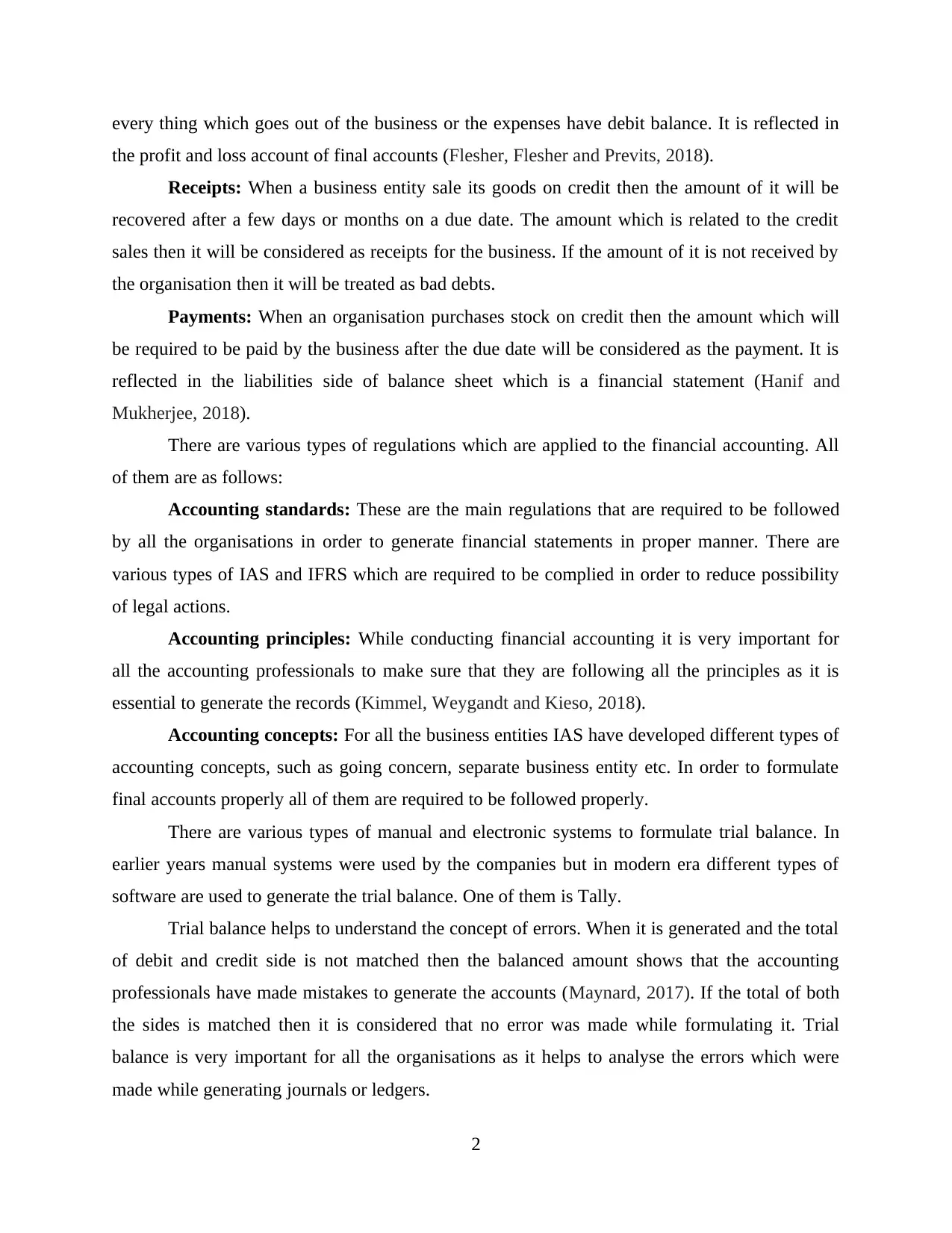
every thing which goes out of the business or the expenses have debit balance. It is reflected in
the profit and loss account of final accounts (Flesher, Flesher and Previts, 2018).
Receipts: When a business entity sale its goods on credit then the amount of it will be
recovered after a few days or months on a due date. The amount which is related to the credit
sales then it will be considered as receipts for the business. If the amount of it is not received by
the organisation then it will be treated as bad debts.
Payments: When an organisation purchases stock on credit then the amount which will
be required to be paid by the business after the due date will be considered as the payment. It is
reflected in the liabilities side of balance sheet which is a financial statement (Hanif and
Mukherjee, 2018).
There are various types of regulations which are applied to the financial accounting. All
of them are as follows:
Accounting standards: These are the main regulations that are required to be followed
by all the organisations in order to generate financial statements in proper manner. There are
various types of IAS and IFRS which are required to be complied in order to reduce possibility
of legal actions.
Accounting principles: While conducting financial accounting it is very important for
all the accounting professionals to make sure that they are following all the principles as it is
essential to generate the records (Kimmel, Weygandt and Kieso, 2018).
Accounting concepts: For all the business entities IAS have developed different types of
accounting concepts, such as going concern, separate business entity etc. In order to formulate
final accounts properly all of them are required to be followed properly.
There are various types of manual and electronic systems to formulate trial balance. In
earlier years manual systems were used by the companies but in modern era different types of
software are used to generate the trial balance. One of them is Tally.
Trial balance helps to understand the concept of errors. When it is generated and the total
of debit and credit side is not matched then the balanced amount shows that the accounting
professionals have made mistakes to generate the accounts (Maynard, 2017). If the total of both
the sides is matched then it is considered that no error was made while formulating it. Trial
balance is very important for all the organisations as it helps to analyse the errors which were
made while generating journals or ledgers.
2
the profit and loss account of final accounts (Flesher, Flesher and Previts, 2018).
Receipts: When a business entity sale its goods on credit then the amount of it will be
recovered after a few days or months on a due date. The amount which is related to the credit
sales then it will be considered as receipts for the business. If the amount of it is not received by
the organisation then it will be treated as bad debts.
Payments: When an organisation purchases stock on credit then the amount which will
be required to be paid by the business after the due date will be considered as the payment. It is
reflected in the liabilities side of balance sheet which is a financial statement (Hanif and
Mukherjee, 2018).
There are various types of regulations which are applied to the financial accounting. All
of them are as follows:
Accounting standards: These are the main regulations that are required to be followed
by all the organisations in order to generate financial statements in proper manner. There are
various types of IAS and IFRS which are required to be complied in order to reduce possibility
of legal actions.
Accounting principles: While conducting financial accounting it is very important for
all the accounting professionals to make sure that they are following all the principles as it is
essential to generate the records (Kimmel, Weygandt and Kieso, 2018).
Accounting concepts: For all the business entities IAS have developed different types of
accounting concepts, such as going concern, separate business entity etc. In order to formulate
final accounts properly all of them are required to be followed properly.
There are various types of manual and electronic systems to formulate trial balance. In
earlier years manual systems were used by the companies but in modern era different types of
software are used to generate the trial balance. One of them is Tally.
Trial balance helps to understand the concept of errors. When it is generated and the total
of debit and credit side is not matched then the balanced amount shows that the accounting
professionals have made mistakes to generate the accounts (Maynard, 2017). If the total of both
the sides is matched then it is considered that no error was made while formulating it. Trial
balance is very important for all the organisations as it helps to analyse the errors which were
made while generating journals or ledgers.
2
Paraphrase This Document
Need a fresh take? Get an instant paraphrase of this document with our AI Paraphraser
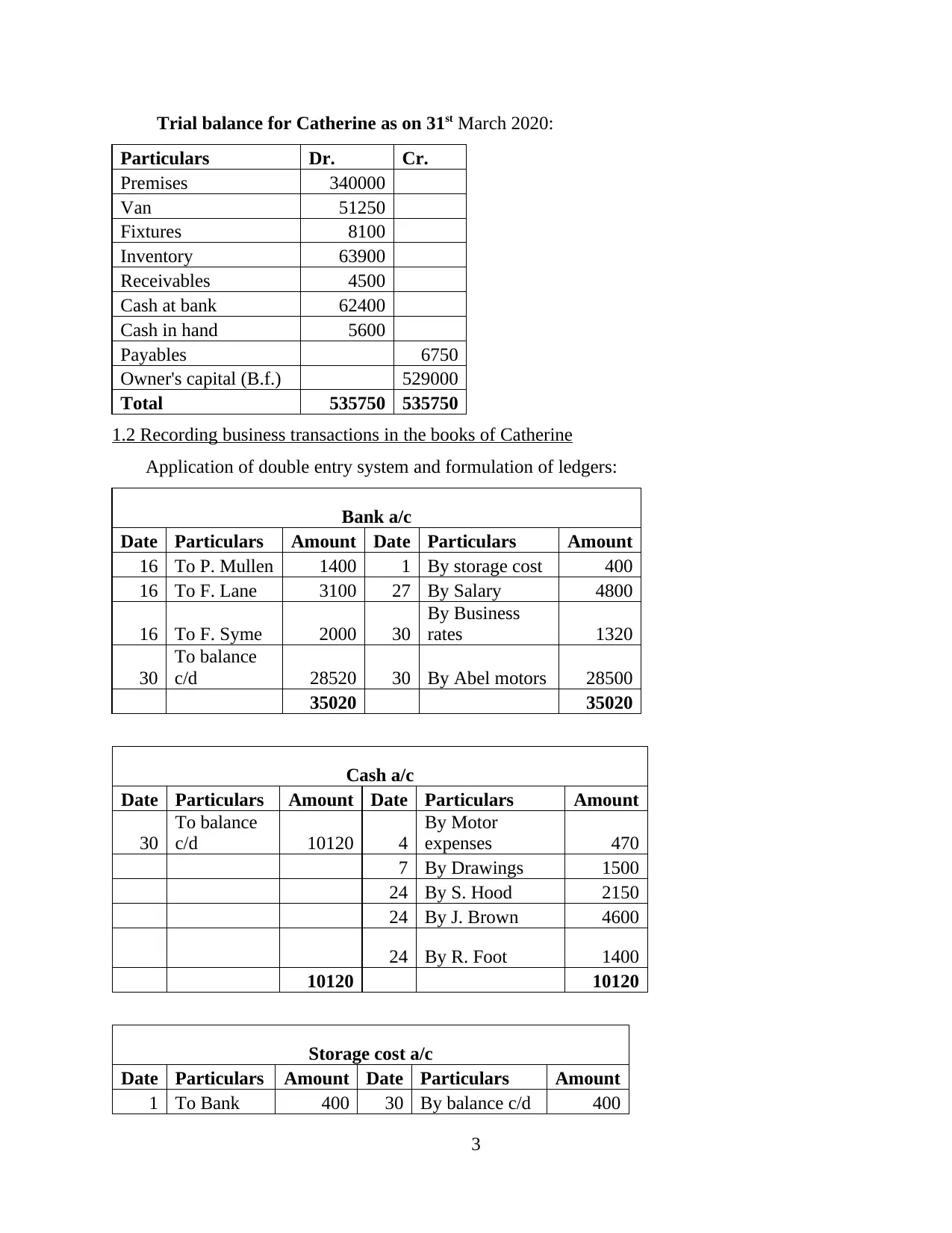
Trial balance for Catherine as on 31st March 2020:
Particulars Dr. Cr.
Premises 340000
Van 51250
Fixtures 8100
Inventory 63900
Receivables 4500
Cash at bank 62400
Cash in hand 5600
Payables 6750
Owner's capital (B.f.) 529000
Total 535750 535750
1.2 Recording business transactions in the books of Catherine
Application of double entry system and formulation of ledgers:
Bank a/c
Date Particulars Amount Date Particulars Amount
16 To P. Mullen 1400 1 By storage cost 400
16 To F. Lane 3100 27 By Salary 4800
16 To F. Syme 2000 30
By Business
rates 1320
30
To balance
c/d 28520 30 By Abel motors 28500
35020 35020
Cash a/c
Date Particulars Amount Date Particulars Amount
30
To balance
c/d 10120 4
By Motor
expenses 470
7 By Drawings 1500
24 By S. Hood 2150
24 By J. Brown 4600
24 By R. Foot 1400
10120 10120
Storage cost a/c
Date Particulars Amount Date Particulars Amount
1 To Bank 400 30 By balance c/d 400
3
Particulars Dr. Cr.
Premises 340000
Van 51250
Fixtures 8100
Inventory 63900
Receivables 4500
Cash at bank 62400
Cash in hand 5600
Payables 6750
Owner's capital (B.f.) 529000
Total 535750 535750
1.2 Recording business transactions in the books of Catherine
Application of double entry system and formulation of ledgers:
Bank a/c
Date Particulars Amount Date Particulars Amount
16 To P. Mullen 1400 1 By storage cost 400
16 To F. Lane 3100 27 By Salary 4800
16 To F. Syme 2000 30
By Business
rates 1320
30
To balance
c/d 28520 30 By Abel motors 28500
35020 35020
Cash a/c
Date Particulars Amount Date Particulars Amount
30
To balance
c/d 10120 4
By Motor
expenses 470
7 By Drawings 1500
24 By S. Hood 2150
24 By J. Brown 4600
24 By R. Foot 1400
10120 10120
Storage cost a/c
Date Particulars Amount Date Particulars Amount
1 To Bank 400 30 By balance c/d 400
3
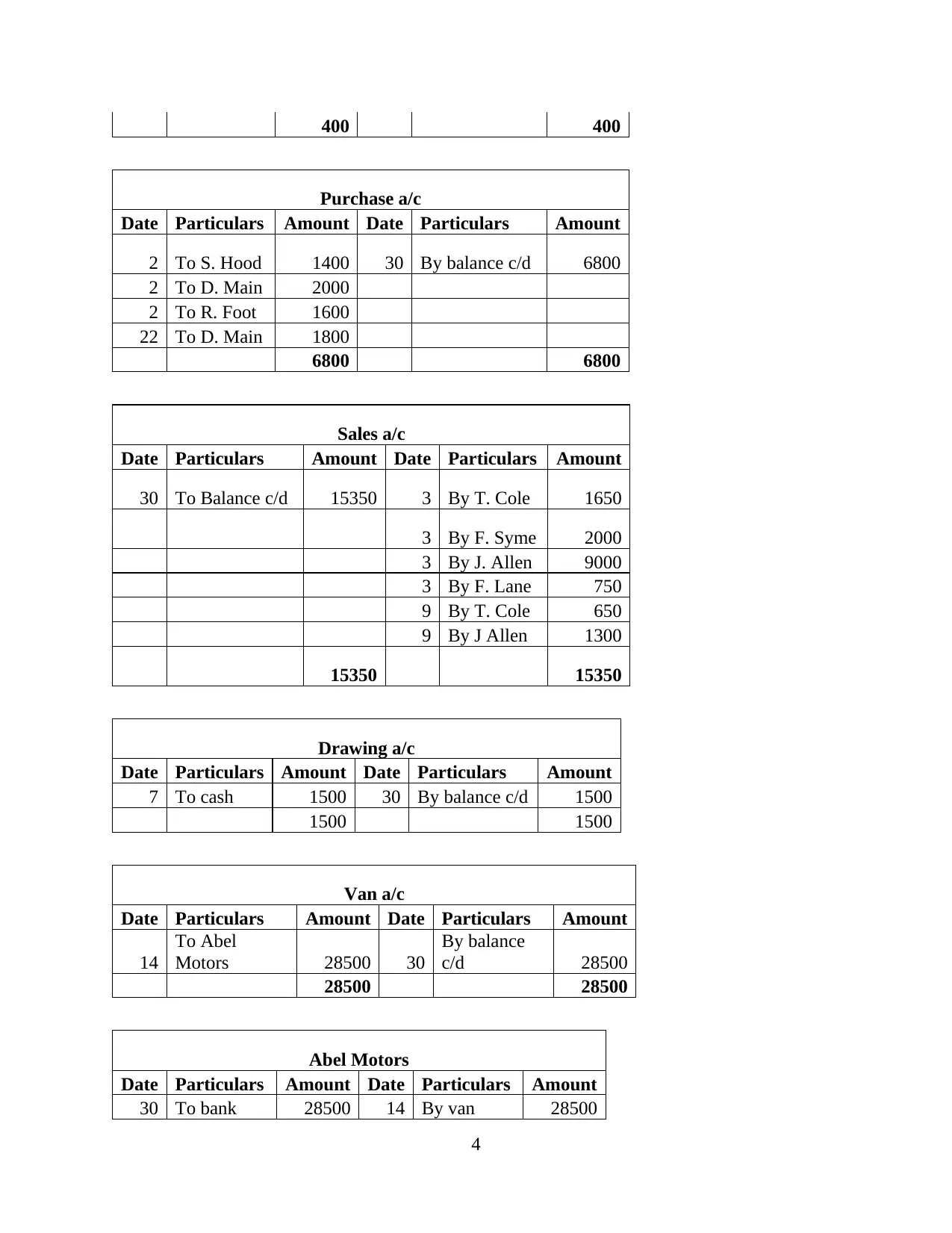
400 400
Purchase a/c
Date Particulars Amount Date Particulars Amount
2 To S. Hood 1400 30 By balance c/d 6800
2 To D. Main 2000
2 To R. Foot 1600
22 To D. Main 1800
6800 6800
Sales a/c
Date Particulars Amount Date Particulars Amount
30 To Balance c/d 15350 3 By T. Cole 1650
3 By F. Syme 2000
3 By J. Allen 9000
3 By F. Lane 750
9 By T. Cole 650
9 By J Allen 1300
15350 15350
Drawing a/c
Date Particulars Amount Date Particulars Amount
7 To cash 1500 30 By balance c/d 1500
1500 1500
Van a/c
Date Particulars Amount Date Particulars Amount
14
To Abel
Motors 28500 30
By balance
c/d 28500
28500 28500
Abel Motors
Date Particulars Amount Date Particulars Amount
30 To bank 28500 14 By van 28500
4
Purchase a/c
Date Particulars Amount Date Particulars Amount
2 To S. Hood 1400 30 By balance c/d 6800
2 To D. Main 2000
2 To R. Foot 1600
22 To D. Main 1800
6800 6800
Sales a/c
Date Particulars Amount Date Particulars Amount
30 To Balance c/d 15350 3 By T. Cole 1650
3 By F. Syme 2000
3 By J. Allen 9000
3 By F. Lane 750
9 By T. Cole 650
9 By J Allen 1300
15350 15350
Drawing a/c
Date Particulars Amount Date Particulars Amount
7 To cash 1500 30 By balance c/d 1500
1500 1500
Van a/c
Date Particulars Amount Date Particulars Amount
14
To Abel
Motors 28500 30
By balance
c/d 28500
28500 28500
Abel Motors
Date Particulars Amount Date Particulars Amount
30 To bank 28500 14 By van 28500
4
⊘ This is a preview!⊘
Do you want full access?
Subscribe today to unlock all pages.

Trusted by 1+ million students worldwide
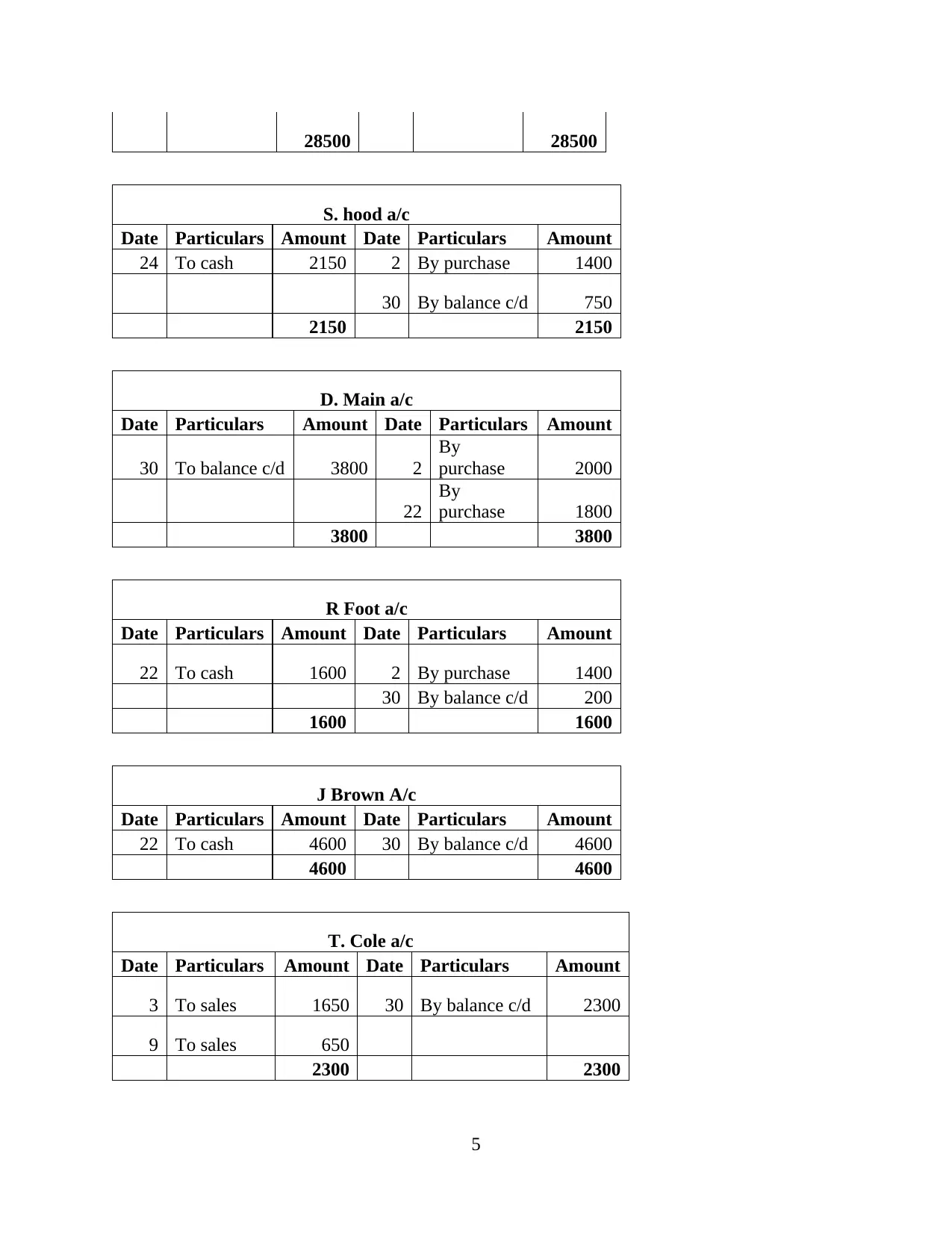
28500 28500
S. hood a/c
Date Particulars Amount Date Particulars Amount
24 To cash 2150 2 By purchase 1400
30 By balance c/d 750
2150 2150
D. Main a/c
Date Particulars Amount Date Particulars Amount
30 To balance c/d 3800 2
By
purchase 2000
22
By
purchase 1800
3800 3800
R Foot a/c
Date Particulars Amount Date Particulars Amount
22 To cash 1600 2 By purchase 1400
30 By balance c/d 200
1600 1600
J Brown A/c
Date Particulars Amount Date Particulars Amount
22 To cash 4600 30 By balance c/d 4600
4600 4600
T. Cole a/c
Date Particulars Amount Date Particulars Amount
3 To sales 1650 30 By balance c/d 2300
9 To sales 650
2300 2300
5
S. hood a/c
Date Particulars Amount Date Particulars Amount
24 To cash 2150 2 By purchase 1400
30 By balance c/d 750
2150 2150
D. Main a/c
Date Particulars Amount Date Particulars Amount
30 To balance c/d 3800 2
By
purchase 2000
22
By
purchase 1800
3800 3800
R Foot a/c
Date Particulars Amount Date Particulars Amount
22 To cash 1600 2 By purchase 1400
30 By balance c/d 200
1600 1600
J Brown A/c
Date Particulars Amount Date Particulars Amount
22 To cash 4600 30 By balance c/d 4600
4600 4600
T. Cole a/c
Date Particulars Amount Date Particulars Amount
3 To sales 1650 30 By balance c/d 2300
9 To sales 650
2300 2300
5
Paraphrase This Document
Need a fresh take? Get an instant paraphrase of this document with our AI Paraphraser
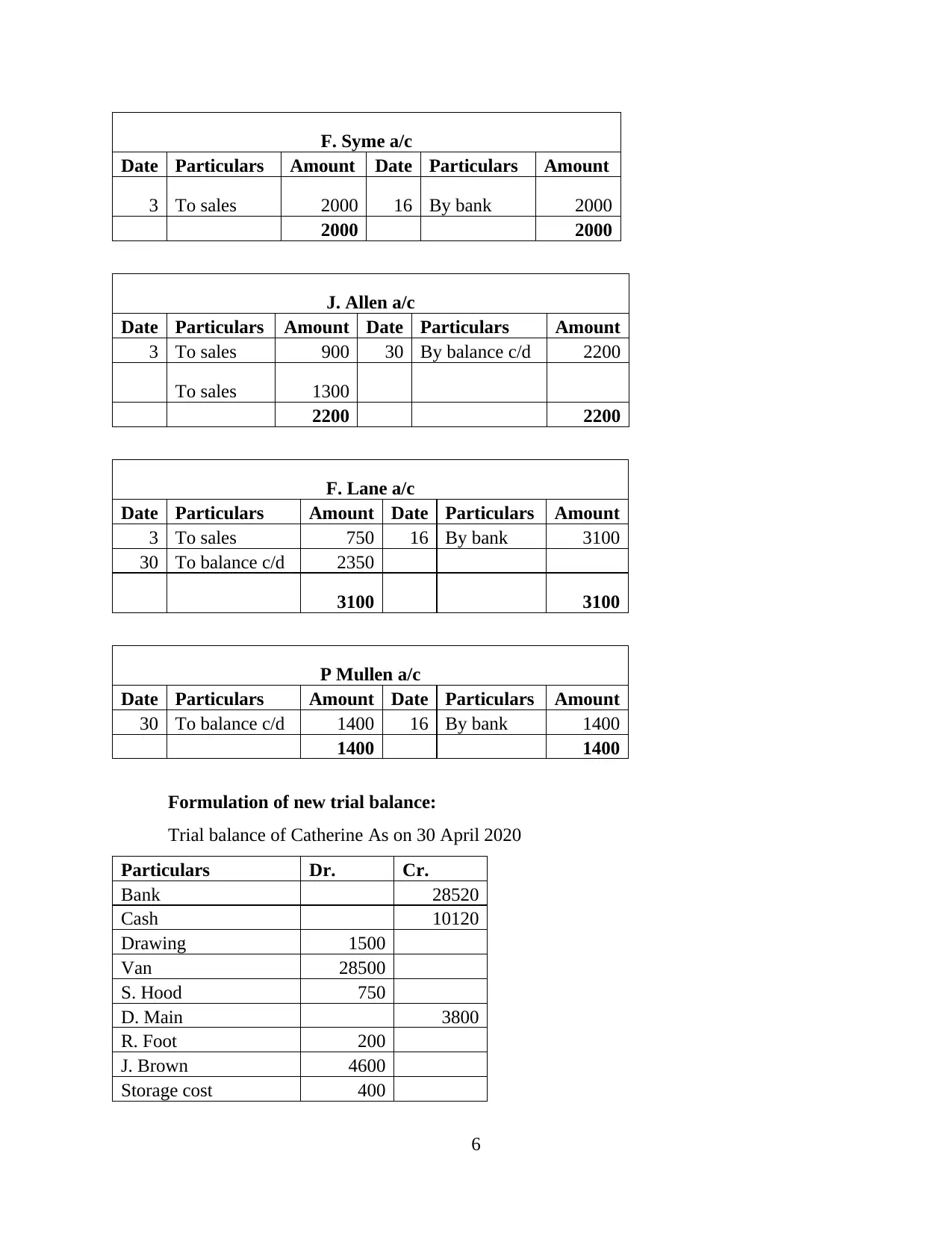
F. Syme a/c
Date Particulars Amount Date Particulars Amount
3 To sales 2000 16 By bank 2000
2000 2000
J. Allen a/c
Date Particulars Amount Date Particulars Amount
3 To sales 900 30 By balance c/d 2200
To sales 1300
2200 2200
F. Lane a/c
Date Particulars Amount Date Particulars Amount
3 To sales 750 16 By bank 3100
30 To balance c/d 2350
3100 3100
P Mullen a/c
Date Particulars Amount Date Particulars Amount
30 To balance c/d 1400 16 By bank 1400
1400 1400
Formulation of new trial balance:
Trial balance of Catherine As on 30 April 2020
Particulars Dr. Cr.
Bank 28520
Cash 10120
Drawing 1500
Van 28500
S. Hood 750
D. Main 3800
R. Foot 200
J. Brown 4600
Storage cost 400
6
Date Particulars Amount Date Particulars Amount
3 To sales 2000 16 By bank 2000
2000 2000
J. Allen a/c
Date Particulars Amount Date Particulars Amount
3 To sales 900 30 By balance c/d 2200
To sales 1300
2200 2200
F. Lane a/c
Date Particulars Amount Date Particulars Amount
3 To sales 750 16 By bank 3100
30 To balance c/d 2350
3100 3100
P Mullen a/c
Date Particulars Amount Date Particulars Amount
30 To balance c/d 1400 16 By bank 1400
1400 1400
Formulation of new trial balance:
Trial balance of Catherine As on 30 April 2020
Particulars Dr. Cr.
Bank 28520
Cash 10120
Drawing 1500
Van 28500
S. Hood 750
D. Main 3800
R. Foot 200
J. Brown 4600
Storage cost 400
6
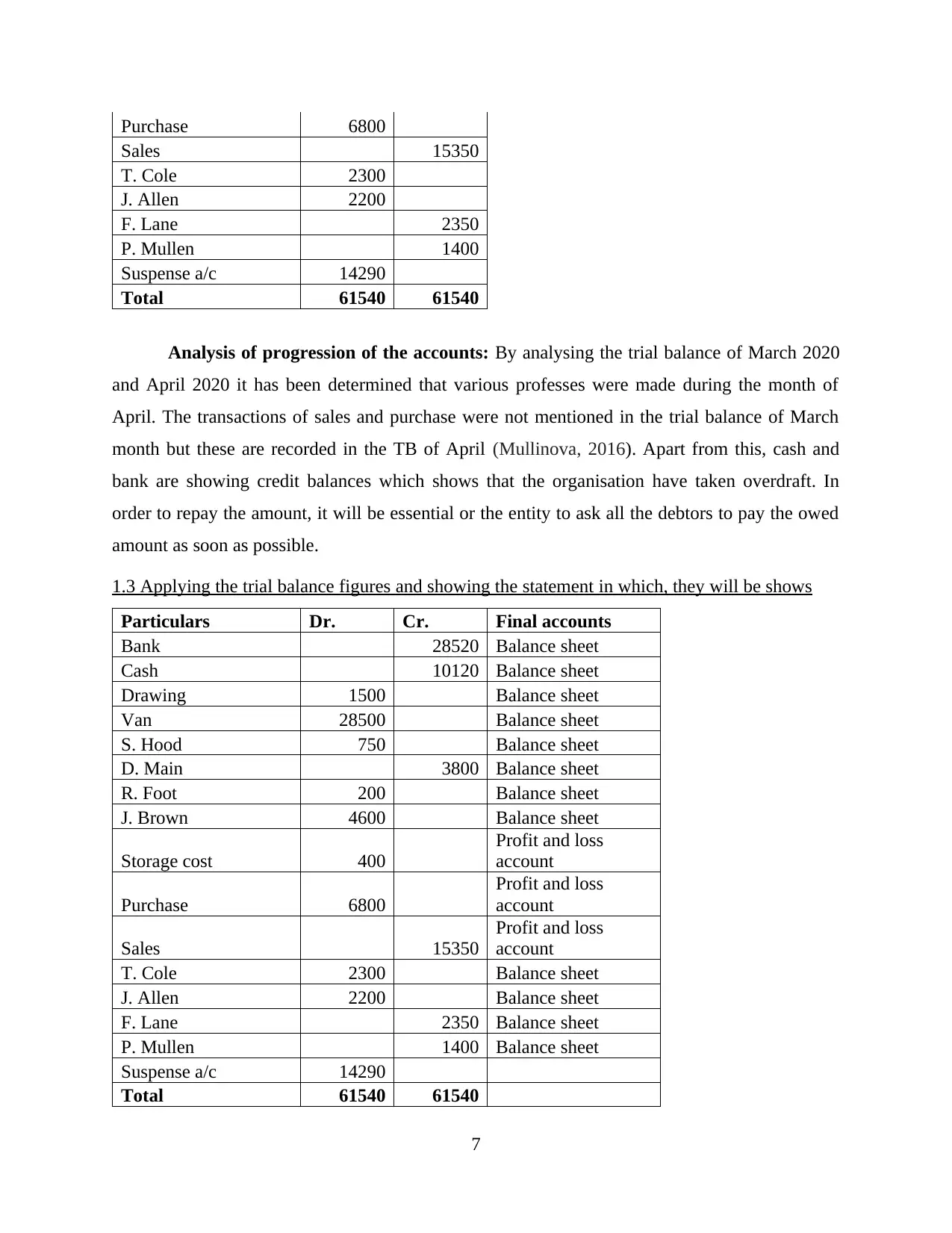
Purchase 6800
Sales 15350
T. Cole 2300
J. Allen 2200
F. Lane 2350
P. Mullen 1400
Suspense a/c 14290
Total 61540 61540
Analysis of progression of the accounts: By analysing the trial balance of March 2020
and April 2020 it has been determined that various professes were made during the month of
April. The transactions of sales and purchase were not mentioned in the trial balance of March
month but these are recorded in the TB of April (Mullinova, 2016). Apart from this, cash and
bank are showing credit balances which shows that the organisation have taken overdraft. In
order to repay the amount, it will be essential or the entity to ask all the debtors to pay the owed
amount as soon as possible.
1.3 Applying the trial balance figures and showing the statement in which, they will be shows
Particulars Dr. Cr. Final accounts
Bank 28520 Balance sheet
Cash 10120 Balance sheet
Drawing 1500 Balance sheet
Van 28500 Balance sheet
S. Hood 750 Balance sheet
D. Main 3800 Balance sheet
R. Foot 200 Balance sheet
J. Brown 4600 Balance sheet
Storage cost 400
Profit and loss
account
Purchase 6800
Profit and loss
account
Sales 15350
Profit and loss
account
T. Cole 2300 Balance sheet
J. Allen 2200 Balance sheet
F. Lane 2350 Balance sheet
P. Mullen 1400 Balance sheet
Suspense a/c 14290
Total 61540 61540
7
Sales 15350
T. Cole 2300
J. Allen 2200
F. Lane 2350
P. Mullen 1400
Suspense a/c 14290
Total 61540 61540
Analysis of progression of the accounts: By analysing the trial balance of March 2020
and April 2020 it has been determined that various professes were made during the month of
April. The transactions of sales and purchase were not mentioned in the trial balance of March
month but these are recorded in the TB of April (Mullinova, 2016). Apart from this, cash and
bank are showing credit balances which shows that the organisation have taken overdraft. In
order to repay the amount, it will be essential or the entity to ask all the debtors to pay the owed
amount as soon as possible.
1.3 Applying the trial balance figures and showing the statement in which, they will be shows
Particulars Dr. Cr. Final accounts
Bank 28520 Balance sheet
Cash 10120 Balance sheet
Drawing 1500 Balance sheet
Van 28500 Balance sheet
S. Hood 750 Balance sheet
D. Main 3800 Balance sheet
R. Foot 200 Balance sheet
J. Brown 4600 Balance sheet
Storage cost 400
Profit and loss
account
Purchase 6800
Profit and loss
account
Sales 15350
Profit and loss
account
T. Cole 2300 Balance sheet
J. Allen 2200 Balance sheet
F. Lane 2350 Balance sheet
P. Mullen 1400 Balance sheet
Suspense a/c 14290
Total 61540 61540
7
⊘ This is a preview!⊘
Do you want full access?
Subscribe today to unlock all pages.

Trusted by 1+ million students worldwide
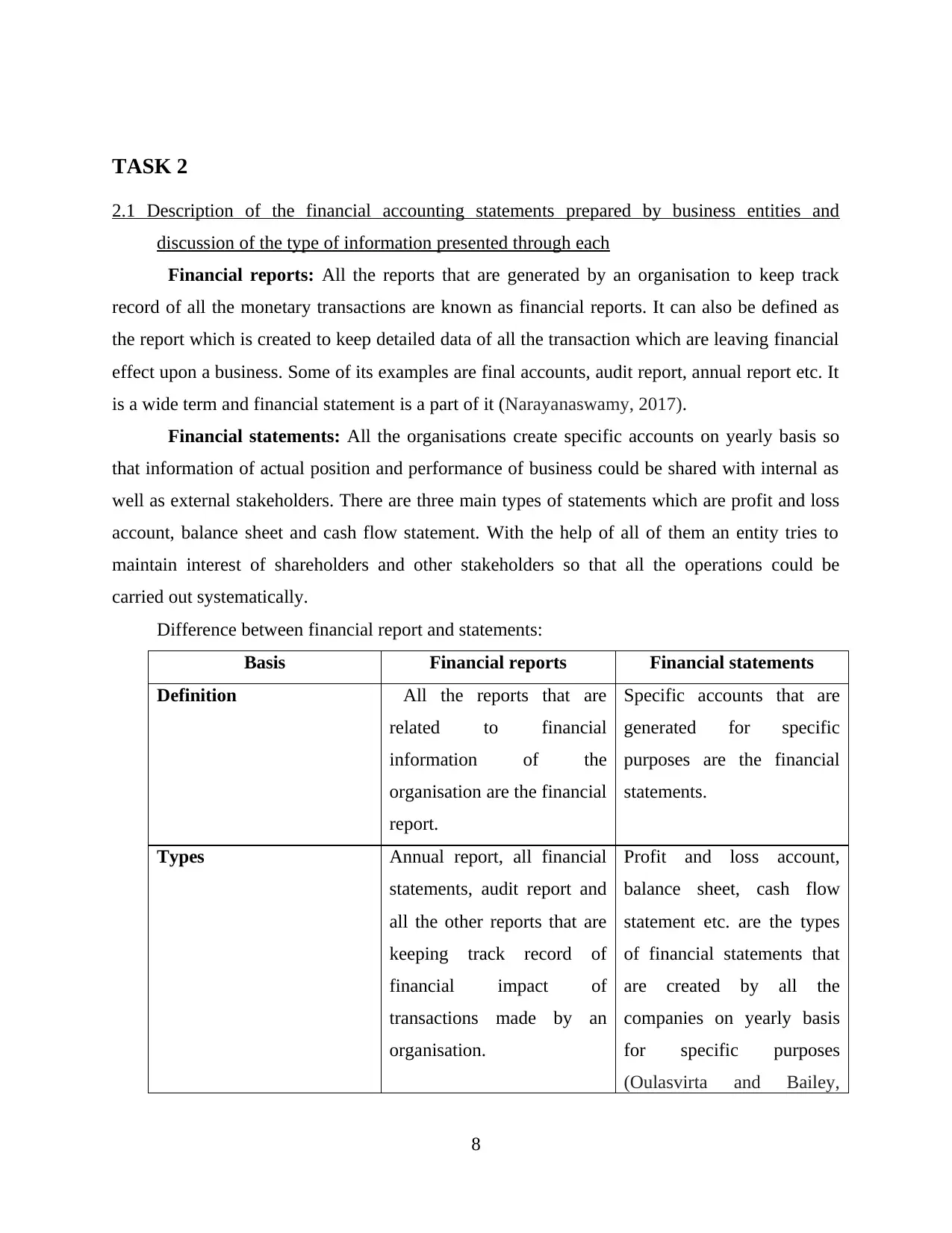
TASK 2
2.1 Description of the financial accounting statements prepared by business entities and
discussion of the type of information presented through each
Financial reports: All the reports that are generated by an organisation to keep track
record of all the monetary transactions are known as financial reports. It can also be defined as
the report which is created to keep detailed data of all the transaction which are leaving financial
effect upon a business. Some of its examples are final accounts, audit report, annual report etc. It
is a wide term and financial statement is a part of it (Narayanaswamy, 2017).
Financial statements: All the organisations create specific accounts on yearly basis so
that information of actual position and performance of business could be shared with internal as
well as external stakeholders. There are three main types of statements which are profit and loss
account, balance sheet and cash flow statement. With the help of all of them an entity tries to
maintain interest of shareholders and other stakeholders so that all the operations could be
carried out systematically.
Difference between financial report and statements:
Basis Financial reports Financial statements
Definition All the reports that are
related to financial
information of the
organisation are the financial
report.
Specific accounts that are
generated for specific
purposes are the financial
statements.
Types Annual report, all financial
statements, audit report and
all the other reports that are
keeping track record of
financial impact of
transactions made by an
organisation.
Profit and loss account,
balance sheet, cash flow
statement etc. are the types
of financial statements that
are created by all the
companies on yearly basis
for specific purposes
(Oulasvirta and Bailey,
8
2.1 Description of the financial accounting statements prepared by business entities and
discussion of the type of information presented through each
Financial reports: All the reports that are generated by an organisation to keep track
record of all the monetary transactions are known as financial reports. It can also be defined as
the report which is created to keep detailed data of all the transaction which are leaving financial
effect upon a business. Some of its examples are final accounts, audit report, annual report etc. It
is a wide term and financial statement is a part of it (Narayanaswamy, 2017).
Financial statements: All the organisations create specific accounts on yearly basis so
that information of actual position and performance of business could be shared with internal as
well as external stakeholders. There are three main types of statements which are profit and loss
account, balance sheet and cash flow statement. With the help of all of them an entity tries to
maintain interest of shareholders and other stakeholders so that all the operations could be
carried out systematically.
Difference between financial report and statements:
Basis Financial reports Financial statements
Definition All the reports that are
related to financial
information of the
organisation are the financial
report.
Specific accounts that are
generated for specific
purposes are the financial
statements.
Types Annual report, all financial
statements, audit report and
all the other reports that are
keeping track record of
financial impact of
transactions made by an
organisation.
Profit and loss account,
balance sheet, cash flow
statement etc. are the types
of financial statements that
are created by all the
companies on yearly basis
for specific purposes
(Oulasvirta and Bailey,
8
Paraphrase This Document
Need a fresh take? Get an instant paraphrase of this document with our AI Paraphraser
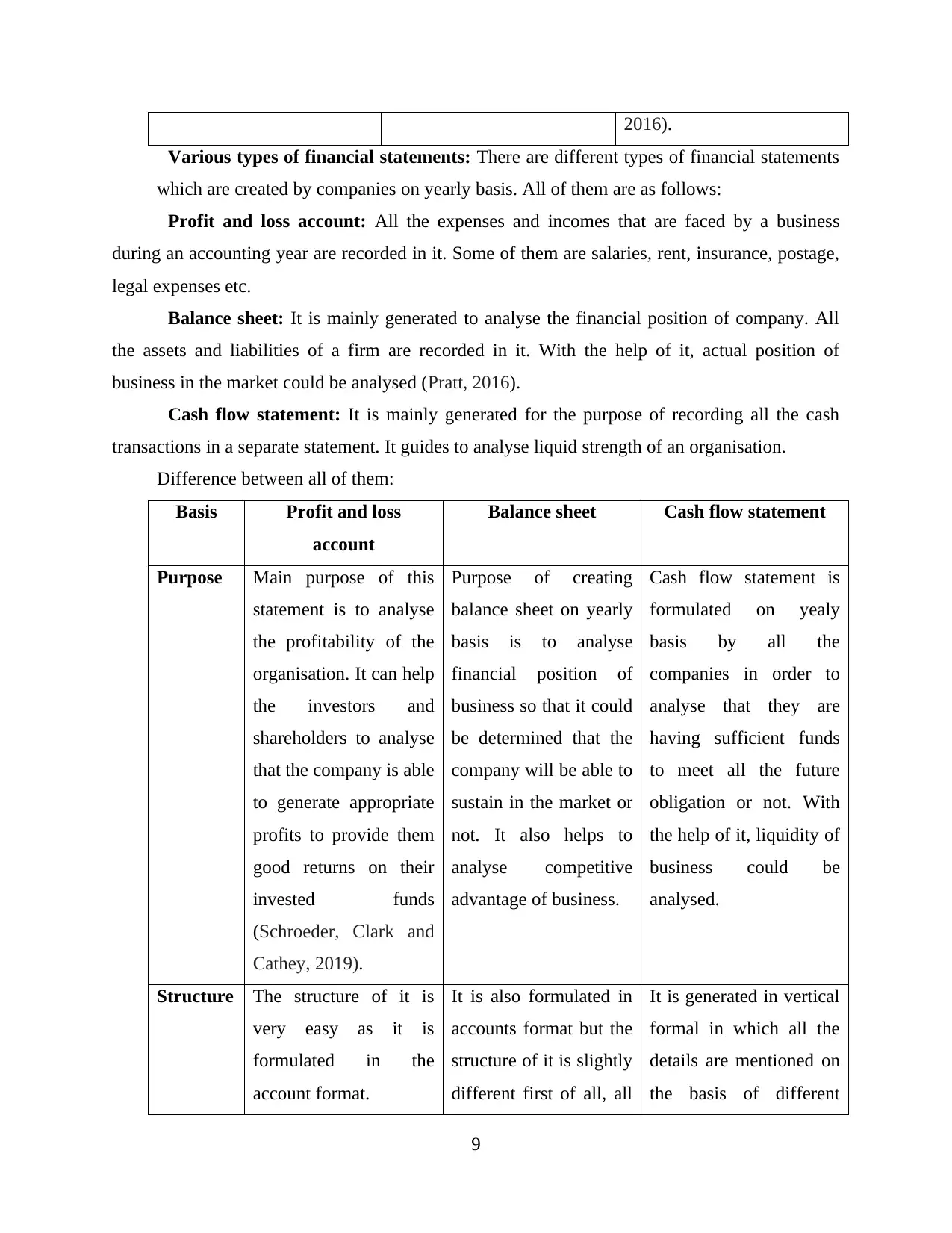
2016).
Various types of financial statements: There are different types of financial statements
which are created by companies on yearly basis. All of them are as follows:
Profit and loss account: All the expenses and incomes that are faced by a business
during an accounting year are recorded in it. Some of them are salaries, rent, insurance, postage,
legal expenses etc.
Balance sheet: It is mainly generated to analyse the financial position of company. All
the assets and liabilities of a firm are recorded in it. With the help of it, actual position of
business in the market could be analysed (Pratt, 2016).
Cash flow statement: It is mainly generated for the purpose of recording all the cash
transactions in a separate statement. It guides to analyse liquid strength of an organisation.
Difference between all of them:
Basis Profit and loss
account
Balance sheet Cash flow statement
Purpose Main purpose of this
statement is to analyse
the profitability of the
organisation. It can help
the investors and
shareholders to analyse
that the company is able
to generate appropriate
profits to provide them
good returns on their
invested funds
(Schroeder, Clark and
Cathey, 2019).
Purpose of creating
balance sheet on yearly
basis is to analyse
financial position of
business so that it could
be determined that the
company will be able to
sustain in the market or
not. It also helps to
analyse competitive
advantage of business.
Cash flow statement is
formulated on yealy
basis by all the
companies in order to
analyse that they are
having sufficient funds
to meet all the future
obligation or not. With
the help of it, liquidity of
business could be
analysed.
Structure The structure of it is
very easy as it is
formulated in the
account format.
It is also formulated in
accounts format but the
structure of it is slightly
different first of all, all
It is generated in vertical
formal in which all the
details are mentioned on
the basis of different
9
Various types of financial statements: There are different types of financial statements
which are created by companies on yearly basis. All of them are as follows:
Profit and loss account: All the expenses and incomes that are faced by a business
during an accounting year are recorded in it. Some of them are salaries, rent, insurance, postage,
legal expenses etc.
Balance sheet: It is mainly generated to analyse the financial position of company. All
the assets and liabilities of a firm are recorded in it. With the help of it, actual position of
business in the market could be analysed (Pratt, 2016).
Cash flow statement: It is mainly generated for the purpose of recording all the cash
transactions in a separate statement. It guides to analyse liquid strength of an organisation.
Difference between all of them:
Basis Profit and loss
account
Balance sheet Cash flow statement
Purpose Main purpose of this
statement is to analyse
the profitability of the
organisation. It can help
the investors and
shareholders to analyse
that the company is able
to generate appropriate
profits to provide them
good returns on their
invested funds
(Schroeder, Clark and
Cathey, 2019).
Purpose of creating
balance sheet on yearly
basis is to analyse
financial position of
business so that it could
be determined that the
company will be able to
sustain in the market or
not. It also helps to
analyse competitive
advantage of business.
Cash flow statement is
formulated on yealy
basis by all the
companies in order to
analyse that they are
having sufficient funds
to meet all the future
obligation or not. With
the help of it, liquidity of
business could be
analysed.
Structure The structure of it is
very easy as it is
formulated in the
account format.
It is also formulated in
accounts format but the
structure of it is slightly
different first of all, all
It is generated in vertical
formal in which all the
details are mentioned on
the basis of different
9
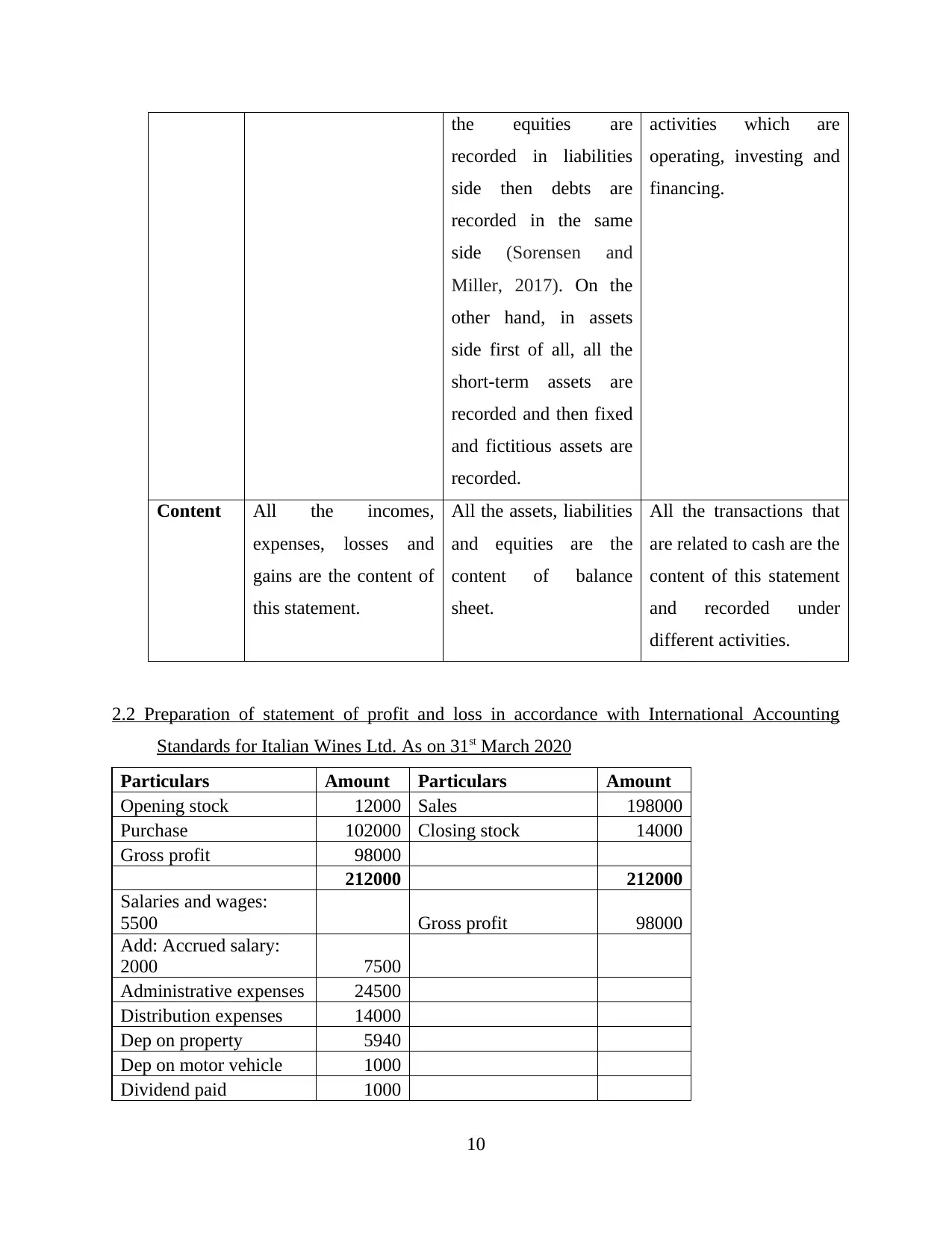
the equities are
recorded in liabilities
side then debts are
recorded in the same
side (Sorensen and
Miller, 2017). On the
other hand, in assets
side first of all, all the
short-term assets are
recorded and then fixed
and fictitious assets are
recorded.
activities which are
operating, investing and
financing.
Content All the incomes,
expenses, losses and
gains are the content of
this statement.
All the assets, liabilities
and equities are the
content of balance
sheet.
All the transactions that
are related to cash are the
content of this statement
and recorded under
different activities.
2.2 Preparation of statement of profit and loss in accordance with International Accounting
Standards for Italian Wines Ltd. As on 31st March 2020
Particulars Amount Particulars Amount
Opening stock 12000 Sales 198000
Purchase 102000 Closing stock 14000
Gross profit 98000
212000 212000
Salaries and wages:
5500 Gross profit 98000
Add: Accrued salary:
2000 7500
Administrative expenses 24500
Distribution expenses 14000
Dep on property 5940
Dep on motor vehicle 1000
Dividend paid 1000
10
recorded in liabilities
side then debts are
recorded in the same
side (Sorensen and
Miller, 2017). On the
other hand, in assets
side first of all, all the
short-term assets are
recorded and then fixed
and fictitious assets are
recorded.
activities which are
operating, investing and
financing.
Content All the incomes,
expenses, losses and
gains are the content of
this statement.
All the assets, liabilities
and equities are the
content of balance
sheet.
All the transactions that
are related to cash are the
content of this statement
and recorded under
different activities.
2.2 Preparation of statement of profit and loss in accordance with International Accounting
Standards for Italian Wines Ltd. As on 31st March 2020
Particulars Amount Particulars Amount
Opening stock 12000 Sales 198000
Purchase 102000 Closing stock 14000
Gross profit 98000
212000 212000
Salaries and wages:
5500 Gross profit 98000
Add: Accrued salary:
2000 7500
Administrative expenses 24500
Distribution expenses 14000
Dep on property 5940
Dep on motor vehicle 1000
Dividend paid 1000
10
⊘ This is a preview!⊘
Do you want full access?
Subscribe today to unlock all pages.

Trusted by 1+ million students worldwide
1 out of 19
Related Documents
Your All-in-One AI-Powered Toolkit for Academic Success.
+13062052269
info@desklib.com
Available 24*7 on WhatsApp / Email
![[object Object]](/_next/static/media/star-bottom.7253800d.svg)
Unlock your academic potential
Copyright © 2020–2025 A2Z Services. All Rights Reserved. Developed and managed by ZUCOL.



